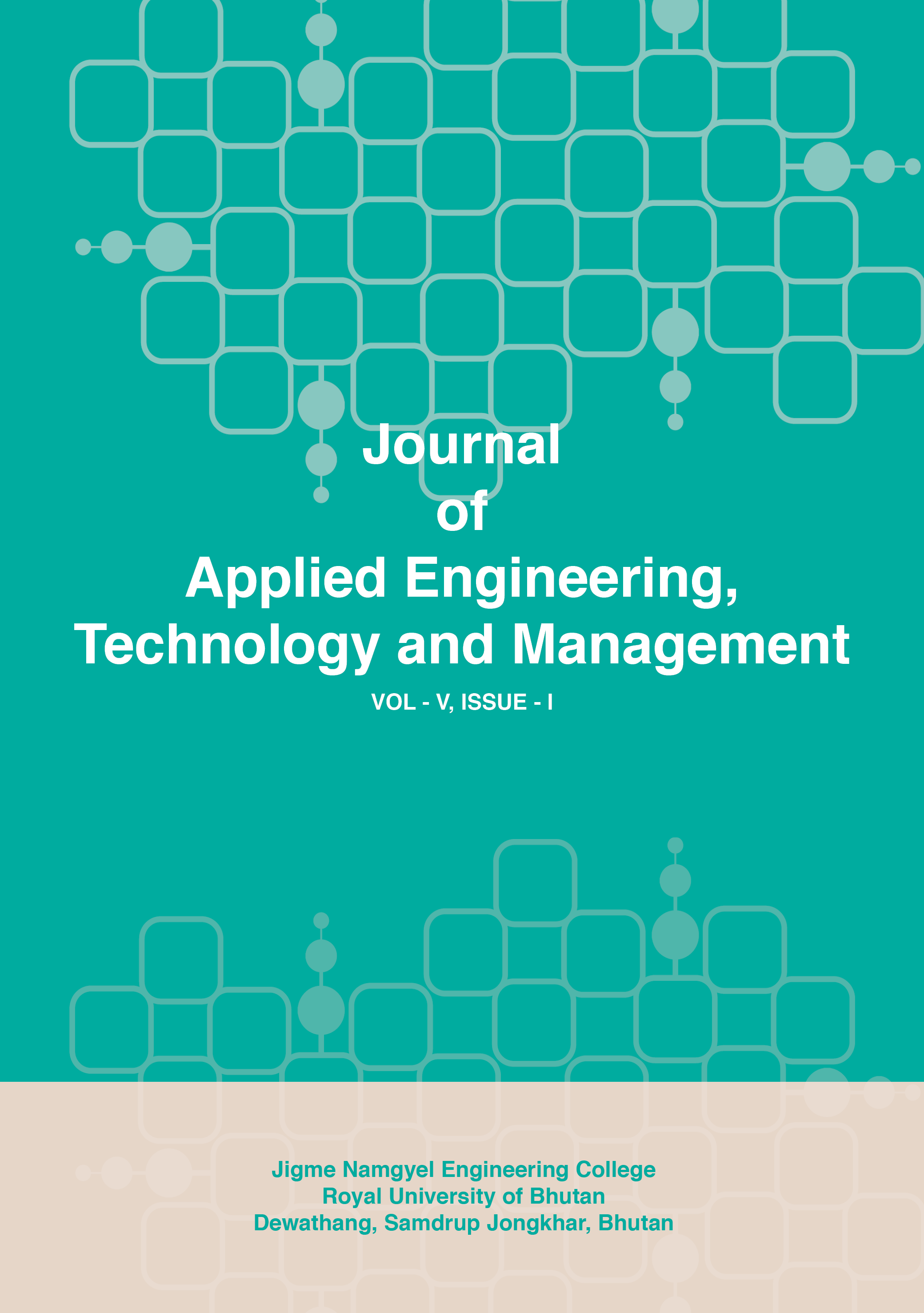Broken Rotor Bar Fault Detection in Induction Motors Using Motor Current Signature Analysis (MCSA)
DOI:
https://doi.org/10.54417/jaetm.v5i1.147Keywords:
Induction motors , Broken Rotor Bar (BRB), Fast Fourier Transform (FFT), Windowing functionsAbstract
Induction motors are commonly used in various industrial applications due to their reliability and robustness. However, they are susceptible to faults that can compromise their performance and efficiency. One of the common faults encountered in induction motors is Broken Rotor Bars, which can lead to rotor imbalance, increase vibration, and reduce the efficiency of the motor. Detecting and diagnosing this fault is critical to ensure the proper operation of the motors for industrial purposes and prevent costly downtime. This paper investigates the comparative current signature analysis of Broken Rotor Bar (BRB) fault detection in induction motors using different windowing functions. The study explores the effectiveness of various windowing functions including Hanning, Hamming, Blackman, and Flattop, in enhancing the analysis of stator current signals for fault detection purposes. The analysis is conducted using Fast Fourier Transform (FFT) techniques. The findings provide insights into the impact of windowing functions on fault detection performance and suitability for motor maintenance applications, specifically in detecting faults such as broken rotor bar faults in induction motors.
References
[1] P. S. Bhowmik, S. Pradhan and M. Prakash, “Fault Diagnostic and Monitoring Methods of Induction Motor”, International Journal of Applied Control, Electrical and Electronics Engineering (IJACEE, vol. 1, no. 1, 2013.
[2] J. Wang, R. X. Gao, and R. Yan, "Broken Rotor Bar Diagnosis for Induction Motors-A Review", Journal of Physics, no. 305, pp. 1-2, 2011, doi: 10.1088/1742-6590/305/1/012026.
[3] O. E. Hassen, M. Amer, A. K. Abdelsalam and B. W. Willaims, “Induction Motor Broken Rotor Bar Fault Detection Techniques Based on Fault Signature analysis”, IET Electic Power Applications, vol. 12(7), pp. 895, 2018.
[4] S.K. Ahamed, S. Karmakar, A. Sarkar, M. Mitra, and S. Sengupta, “Diagnosis of Broken Rotor Bar Fault of Induction Motor Through Envelope Analysis of Motor Startup Current Using Hibert and Wavelet Transform”, Innovative Systems Design and Engineering, vol.2, no.4, pp. 163-165, 2011. [Online]. Available: https://www.iiste.org
[5] M. E. E. Atta, D. K. Ibrahm and M. I. Gilang, “Broken Bar Fault Detect and Diagnosis Techniques for Induction Motors and Drives: State of the Art”, IEEE Access, vol.10, pp.88504-88504, doi: 10.1169/ACCESS.2022.3200058 [Online]. Available: https://creativecommonsorg/licenses/by/4.0
[6] S. Chen, "Induction Machine Broken Rotor Bar Diagnostics Using Prony Analysis”, pp. 7-13, 2008.
[7] D. Nguyen. E. Zwanenburg, S. Limmer, W. Luijben, M. Olhofer and T. Back, “A Combination of Fourier Transform and Machine Learning for Fault Detection and Diagnosis of Induction Motor- a Review”, Honda Research Institute Europe GmbH, 2021, https://doi.org/10.1109/DSA52907,2021.00053
[8] C. Marcelo, J. P. Fossatti and J. I. Terra, “Fault Diagnosis of Induction Motors Based on FFT”, Fourier Transform-Signal Processing, Dr. S. Salih (Ed), ISSN: 978-953-51-0453-7, Intech, Available from: https://www.intechopen.com/books/fourier-transform-signal-processing/fault-diagnosis-of-induction-motors-based-on-fft
[9] S. Halder, S. Bhat, D. Zychma and P. Sowa, “Broken Rotor Bar Fault Diagnosis Technique Based on Motor Current Signature Analysis for Induction Motor”, vol.15, no.22, pp. 1-2, https://doi.org/10.3390/en15288569
[10] A. Silva, “Induction Motor Fault Diagnostic and Monitoring Methods”, pp.38-39, 2006, https://www.researchgat.net/publication/243055807_Induction_fault_diagnostic_and_monitoring_methods
[11] S. Randy, N. Ertugoul, W. L. Soong, D. A. Gray, C. Hansen, and J. Grieger, “Broken Rotor Bar Fault Detection in Induction Motors Using Starting Current Analysis.”
[12] S. Zolfaghari, S. B. M. Noor, M. R. Mehrjou, M. H. Marhabari, and N. Mariun, “Broken Rotor Bar Fault Detection and Classification Using Wavelet Packet Signature Analysis Based on Fourier Transform and Multi-layer Perceptron Neural Network”, Applied Science, pp. 3-4, 2018, doi: 10.3390/app8010025.
[Online]. Available: https://www.mdpi.com/journal/applisci
[13] I. Culbert and W. Rhodes, “Using Current Signature Analysis Technology to Reliably Detect Cage Induction Motors”, IEEE, 2005
[14] R. J. R. Troncoso, Sr., “Multirate Signal Processing to Improve FFT-Based Analysis for Detecting Faults in Induction Motors”, IEEE Transactions of Industrial Information, vol.13, no.3, pp.1291, 2017.
[15] S. Koveshnikov, “Machine Learning Methods for Induction Motor Fault Detection”, Master Thesis, pp.16-18, 2023.
[16] M. Ali, S. Shaikh, and Karachi, "Data Acquisition System and Real-Time Monitoring of the Parameters of Induction Motor via Wireless Communication", 5th International Electrical Engineering Conference (IEEE 2020), pp. 1-4, 2020.
[17] K. M. Siddiqui, K. Sahay, and V. K. Giri, “Health Monitoring and Fault Diagnosis in Induction Motor”, International Journal of Advanced Research in Electrical, Electronics and Instrumentation Engineering, vol.3, no.1, pp.6551-6553, 2014, https://www.ijareeric.com
[18] L. Frosini, C. Harlisca, and L. Szabo, "Induction Machine Bearing Faults Detection Means of Statistical Processing of the Stray Flux Measurements", IEEE Transactions on Industrial Electronics, vol.62, no.3, 2015.
[19] Construction of Induction Motor”, Rohini College of Engineering and Technology. https://www.rcet.org.in/uploads/academics/rohni_83443710622.pdf
[20] “Understanding FFTs and Windowing”, [Online]. Available: https://download.ni.com/evaluation/pxi/Understanding%20FFTs%and%20Windowing.pdf
[21] “Download the VS Code”, [Online]. Available: https://Visual_Studio_Code_Editing_Refined
[22] “Python 3.10”, [Online]. Available: https://www.welcometopython.org
[23] Veer Surendra Sai University of Technology, “Electrical Machine-2”, pp.4-9, https://www.vssut.ac.in
[24] Search Engine used: “Google.”
Downloads
Published
How to Cite
Issue
Section
License
Copyright (c) 2025 Copyright (c) 2025 Journal of Applied Engineering, Technology and Management (JAETM)

This work is licensed under a Creative Commons Attribution-NonCommercial 4.0 International License.


